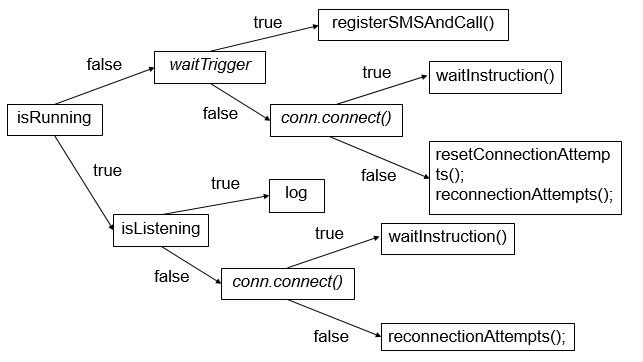Androrat木马静态分析
0x00 前言
Androrat原本是一个对Android设备进行远程管理的工具,但是使用不当的话,其实就相当于是一个木马程序。Androrat现在主要有两个版本,一个是国外原版,另一个是国内开发人员开发的,我这里分析的是国外原版(法国人写的- -|| 看不懂的注释..),没有经过太大改动。
那么它官方给出的功能有:
获取通讯录信息
获取呼叫记录
获取短信和彩信
通过 GPS 获取定位
实时监控接收到的短信
监控手机的呼叫状态
拍照
获取来自麦克风的声音信息
视频
弹窗
发送文本消息
拨号
在浏览器中打开某个网址
震动等
Androrat的工作模式是C/S模式,在pc端或者服务器上安装Androrat的server,在移动设备上安装Androrat的client端。大概的流程是,server端发送指令到client,client对指令做出相应的解释和操作,接着返回数据给server,server展现收到的数据。
client的主界面是需要手动输入server端的ip和port,然后点击按钮启动服务,那如果修改Androrat的源码,指定ip和port(当然这时server就要放置在有外网ip的服务器上啦),默认开启服务,通过其他手段让受害者安装这个修改后的andorat,这样server就可以控制多台肉鸡了。
那我们现在来分析一下Androrat的工作原理:
拿到一个app,想要去进行分析,第一步要从整体上去了解它,那么第一个要去分析的当然就是它的AndroidManifest.xml文件啦.
0x01 AndroidManifest文件
1.申请的权限
| Permission | 权限 |
|---|---|
| android.permission.RECEIVE_SMS | 监控将收到的短信 |
| android.permission.READ_SMS | 读取短信 |
| android.permission.SEND_SMS | 发送短信 |
| android.permission.READ_PHONE_STATE | 获取手机状态 |
| android.permission.PROCESS_OUTGOING_CALLS | 处理拨出电话(监控,修改) |
| android.permission.ACCESS_NETWORK_STATE | 访问网络状态 |
| android.permission.ACCESS_FINE_LOCATION | 访问精确位置 |
| android.permission.INTERNET | 连接网络 |
| android.permission.RECORD_AUDIO | 录音 |
| android.permission.WRITE_EXTERNAL_STORAGE | 允许写扩展存储(SD卡) |
| android.permission.CAMERA | 相机 |
| android.permission.RECEIVE_BOOT_COMPLETED | 开机启动 |
| android.permission.CALL_PHONE | 拨打电话 |
| android.permission.READ_CONTACTS | 获取通讯录 |
| android.permission.VIBRATE | 震动 |
从申请的权限中就可以猜测出程序可能拥有的功能或操作。例如对短信或通话做出处理等,另外还要注意一个权限——android.permission.RECEIVE_BOOT_COMPLETED,当手机开机时,系统就会发出这个RECEIVE_BOOT_COMPLETED的广播,那如果收到这个广播的话也就意味着手机开机了,那么这里申请这个权限也就可以猜测这个app有开机自启的功能。
2.注册的组件
|
|
接下来可以看看注册的组件,可以看到主Activity是LauncherActivity,是程序的入口;一个接收开机广播的Receiver;一个后台服务Client;PhotoActivity可以猜测是和拍照相关的界面;AlarmListener是和一些警告或消息通知相关的Receiver.具体的下文会分析。
0x02 执行过程分析
1.LauncherActivity分析
|
|
LauncherActivity就是打开app看到的第一个界面,主要用于输入服务器端的ip地址和端口,然后启动服务(client),并且设置按钮的属性。那这里其实就可以修改前面提到的功能,指定默认ip和端口,不需要点击按钮就启动服务,甚至没有停止服务的功能…但是我们这里测试是使用内网地址,经常改变,就不修改了。
2.Client分析
从LauncherActivity之后会跳转到Client服务类这里,接着我们分析这里的逻辑。
在源码里可以看到,Client是继承ClientListener,而ClientListener是继承Service,说明Client其实就是一个服务组件。
由于Client是一个Service,所以我们首先关注两个方法,onCreate和onStartCommand。因为当一个服务创建之后首先就会调用onCreate方法,而当一个服务被调用的时候,比如说startService方法启动服务的时候,就会调用onStartCommand这个方法。在一个生命周期里,服务只能被创建一次,但是可以被调用多次,所以onCreate的这个方法只会调用一次,而onStartCommand可以被调用多次。
那么我们先来看看onCreate方法:
|
|
onCreate做的事情是,先实例化SystemInfo类,SystemInfo类在my.app.Library包里,这个类获取设备的相关信息,比如IMEI,PhoneNumber,Country,Operator,SimCountry,SimpOperator和SimSerial等信息。接着实例化ProcessCommand类,这个类非常重要,里面有process方法和loadPreferences方法,主要用于处理从服务器端发来的命令,process方法里判断指令数据的内容,并对指令进行匹配,然后跳转到相应的处理方法,loadPreferences方法有一些初始化操作,比如初始化ip和port还有waitTrigger标志,另外还有设置来电号码白名单,短信号码白名单以及短信内容关键字白名单。
process方法:
|
|
最后调用了loadPreferences方法
|
|
可以看到这里获取初始化的一些参数,而这些参数就是我们在LauncherActivity上看到的一些参数,像ip和port。
分析完onCreate方法之后,我们来看看onStartCommand方法:
主要的逻辑流程其实就是下图:
最理想的情况最后应该到达的地方是waitInstruction方法。
|
|
首先是从intent获取ip和端口
|
|
分析isRunning为false这个分支。
首先注册一个Receiver,监听网络连接变化;然后设置isRunning标识为true,接着实例化Connection类,这个类主要做的工作就是通过socket与服务器端进行连接;接着判断waitTrigger标识
waitTrigger为true的话,就调用registerSMSAndCall方法
|
|
这个方法里注册了两个Receiver组件,SMSreceiver和Callreceiver,那么其实两者做的工作是相似的,比如SMSreceiver,判断来的短信是否是之前设置的白名单项,然后启动Client服务。
waitTrigger为false的话,就调用Connection的connect方法,与服务器进行连接,然后判断是否连接成功,成功了的话就启动一个子线程Thread,调用waitInstruction方法
|
|
这个waitInstruction方法做的事情就是获取指令数据。
那么在这里有个需要注意的地方,Thread会有一个Handler,用于接受子线程发送的数据,并用此数据配合主线程更新UI,里面的handleMessage处理这些数据,根据不同的数据形式实现不同的方法。所以waitInstruction获取的指令数据会由handler处理
|
|
这里调用了processCommand方法
|
|
这个方法里就可以看到关键的procCmd.process(),把指令数据用process方法处理,就是我们之前提到的process方法,根据指令跳转到相应的处理。
回到conn.connect()为true的情况,线程启动之后,会发送刚刚获取到的设备的基本信息给服务器,也就是服务器端看到的,当一个移动设备连接到服务器之后看到的一些基本信息。然后把isListening标识设置为true;接着判断waitTrigger标识,把SMSreceiver和Callreceiver组件卸载掉,因为服务已经启动了,不需要通过监听来短信或来电的方法启动服务。
当然,如果没有连接上服务器,也就是conn.connect()为false的时候,就会调用resetConnectionAttempts()和reconnectionAttempts(),重设和重新连接。
接下来看看isRunning为false这个分支:
|
|
如果isRunning标识为false的话,那么其实做的就是上面连接服务器端,获取指令数据等的一些操作,不同的就是后面只有重连,没有重设。
Client类总结:总的来说,Client类做的事就是初始化相关参数,与服务器端进行连接,并且发送连接设备的相关信息给服务器端,然后等待来自服务器端的指令。
0x03 功能实现分析
在Client类分析里我们提到processCommand的process方法,那么其实从指令的名字基本上都可以判断要做的操作是什么了。在my.app.Library包里,有一些实现的功能类:
- SystemInfo
- AdvancedSystemInfo
- SMSLister
- SMSMonitor
- CallLogLister
- CallMonitor
- ContactsLister
- DirLister
- FileDownloader
- PhotoTaker
- AudioStreamer
- GPSListener
SystemInfo是获取设备的基本信息;AdvancedSystemInfo是获取设备的一些详细信息,点击设备项之后会看到的信息;SMSLister是列举手机里的短信;SMSMonitor是实时监控手机来短信;CallLogLister是获取通话记录;CallMonitor是实时监控手机的来电去电状态;ContactsLister是获取手机通讯录;DirLister列举外部设备的文件目录;FileDownloader是读取这些文件的内容然后发送给服务器端展示;PhotoTaker就是拍照功能了;AudioStreamer是获取媒体数据流;GPSListener是实时获取设备的精确位置(这个功能好像在手机丢了的时候挺好用的;))
0x04 其他分析
1.BootReceiver分析
|
|
可以看到BootReceiver就是一个监听开机广播,然后启动Client服务的一个功能。
2.INOUT_LIBRARY
在这个包里实现了一些比较底层的功能,处理发送到服务器端或从服务器端接收数据的方式。in包里的类处理从服务器端接收数据的情况;out包里处理发送或连接到服务器的情况;Packet包里是对这些数据进行封装,等等
0x05 总结
这次主要通过静态分析的方式去分析Androrat的客户端,大致上对它的执行路径有个清晰的了解,但是比较底层的细节还没有去分析。总的来说,这是一次挺好的学习经验,虽然静态分析花费的时间还蛮多的,容易绕晕,但是去理解一个木马的实现原理还是值得的:)
